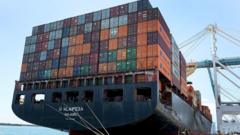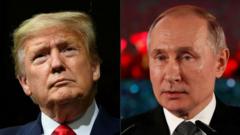The latest WTO report indicates that US tariffs could lead to a downturn in global trade, with predictions of a significant decrease particularly in North America.
US Tariffs Expected to Constrict Global Trade, Warns WTO

US Tariffs Expected to Constrict Global Trade, Warns WTO
World Trade Organization cites uncertainty and retaliatory tariffs as major risks to trade dynamics
The World Trade Organization (WTO) has issued a stern warning regarding the future of global trade, predicting a downward trend in trade volumes for the current year due to the tariffs imposed by US President Donald Trump. The organization highlighted "severe downside risks," which include retaliatory tariffs and ongoing political uncertainty, potentially exacerbating an already sharp decline in the exchange of goods. "In North America, the decline is projected to exceed ten percent," the WTO stated in its report.
Director-General Ngozi Okonjo-Iweala expressed concern over the "decoupling" of the US and China, labeling it a "phenomenon that is really worrying." The WTO's initial expectation of a 2.7% growth in global goods trade for 2025 has been revised to a decrease of 0.2%. Chief economist Ralph Ossa emphasized the ramifications of tariff policies, noting, "Tariffs are a policy lever with wide-ranging, and often unintended consequences." He also pointed out that uncertainty in trade policy dampens trade flows, leading to reduced exports and weakened economic growth.
On April 5, a baseline tariff of 10% on a wide range of foreign imports into the US took effect, although some countries and products are exempt. In contrast, imports from China are subject to a much steeper 145% tariff. The instability triggered by these measures contributed to a drop in US stock market indices as they opened on Wednesday.
Despite the anticipated plunge in trade involving the US, the WTO has forecast potential growth in certain regions, predicting modest increases in exports and imports for Asia and Europe. The report also marks the first time a forecast for services trade has been included—predicting a 4% increase by 2025, approximately one percentage point lower than previous expectations.
Since taking office, Trump has made numerous tariff announcements with the aim of encouraging American consumers to purchase domestic products, suggesting that these tax measures would boost government revenue and stimulate investment. Critics, however, argue that the complexities of revitalizing American manufacturing could span decades, and the economy may face challenges in the interim.
Notably, President Trump has also reversed several of his tariff decisions. Just hours after implementing significant levies affecting about 60 trading partners earlier this month, he announced a 90-day suspension of tariffs for all countries, except China, responding to mounting criticism from both legislators and financial markets. In March, the Bank of England's governor warned that Trump's tariffs could potentially reduce disposable income for UK consumers amid these evolving trade dynamics.
Director-General Ngozi Okonjo-Iweala expressed concern over the "decoupling" of the US and China, labeling it a "phenomenon that is really worrying." The WTO's initial expectation of a 2.7% growth in global goods trade for 2025 has been revised to a decrease of 0.2%. Chief economist Ralph Ossa emphasized the ramifications of tariff policies, noting, "Tariffs are a policy lever with wide-ranging, and often unintended consequences." He also pointed out that uncertainty in trade policy dampens trade flows, leading to reduced exports and weakened economic growth.
On April 5, a baseline tariff of 10% on a wide range of foreign imports into the US took effect, although some countries and products are exempt. In contrast, imports from China are subject to a much steeper 145% tariff. The instability triggered by these measures contributed to a drop in US stock market indices as they opened on Wednesday.
Despite the anticipated plunge in trade involving the US, the WTO has forecast potential growth in certain regions, predicting modest increases in exports and imports for Asia and Europe. The report also marks the first time a forecast for services trade has been included—predicting a 4% increase by 2025, approximately one percentage point lower than previous expectations.
Since taking office, Trump has made numerous tariff announcements with the aim of encouraging American consumers to purchase domestic products, suggesting that these tax measures would boost government revenue and stimulate investment. Critics, however, argue that the complexities of revitalizing American manufacturing could span decades, and the economy may face challenges in the interim.
Notably, President Trump has also reversed several of his tariff decisions. Just hours after implementing significant levies affecting about 60 trading partners earlier this month, he announced a 90-day suspension of tariffs for all countries, except China, responding to mounting criticism from both legislators and financial markets. In March, the Bank of England's governor warned that Trump's tariffs could potentially reduce disposable income for UK consumers amid these evolving trade dynamics.





















